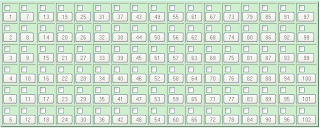Number Cube Probability
Probability is the chance of the outcome of an event of a particular experiment. Probabilities are occurs always numbers between 0(impossible) and 1(possible). The set of all possible outcomes of a particular experiment is called as sample space. For example probability of getting a 3 when rolling a dice is 1/6. In this article we will discuss about probability problems using number cube.
Number Cube Probability - Example Problems
Example 1: If rolling a number cube, what is the probability of getting prime number?
Solution:
Let S be the sample space, n(S) = 6.
A be the event of getting prime number.
A = {2,3, 5}, n(A) = 3
P(A) = `(n(A))/(n(S))` = `3/6` = `1/2`
Example 2: If rolling two number cubes, what is the probability of getting a sum of odd?
Solution:
Let S be the sample space, n(S) = 6 * 6 = 36.
A be the event of getting a sum of odd.
n(A) = {{1, 2), (1, 4), (1, 6)....(6, 1), (6, 3), (6, 5)} = 18
P(A) = `(n(A))/(n(S))` = `18/36` = `1/2`
Therefore probability of getting a sum of odd is `1/2`
Example 3: If rolling two number cubes, what is the probability of getting a sum of 10 or 7?
Solution:
Let S be the sample space, n(S) = 6 * 6 = 36.
A be the event of getting 10.
n(A) = {{4, 6), (5, 5), (6, 4)} = 3
P(A) = `(n(A))/(n(S))` = `3/36` = `1/12`
Let B be the event of getting sum of 7.
n(B) = {(1, 6), (2, 5), (3, 4), (4, 3), (5, 2), (6, 1)} = 6
P(B) = `(n(B))/(n(S))` = `6/36` = `1/6`
P(A or B) = P(A) + P(B) = `1/12` + `1/6` = `1/4`
P(A or B) = `1/4`
Therefore probability of getting a sum of 10 or 7 is `1/4`
Number Cube Probability - Practice Problems
Problem 1: If rolling a number cube, what is the probability of getting composite number?
Problem 2: If rolling two number cubes, what is the probability of getting 9 or 6?
Answer: 1) `2/3` 2) `5/18`
Probability is the chance of the outcome of an event of a particular experiment. Probabilities are occurs always numbers between 0(impossible) and 1(possible). The set of all possible outcomes of a particular experiment is called as sample space. For example probability of getting a 3 when rolling a dice is 1/6. In this article we will discuss about probability problems using number cube.
Number Cube Probability - Example Problems
Example 1: If rolling a number cube, what is the probability of getting prime number?
Solution:
Let S be the sample space, n(S) = 6.
A be the event of getting prime number.
A = {2,3, 5}, n(A) = 3
P(A) = `(n(A))/(n(S))` = `3/6` = `1/2`
Example 2: If rolling two number cubes, what is the probability of getting a sum of odd?
Solution:
Let S be the sample space, n(S) = 6 * 6 = 36.
A be the event of getting a sum of odd.
n(A) = {{1, 2), (1, 4), (1, 6)....(6, 1), (6, 3), (6, 5)} = 18
P(A) = `(n(A))/(n(S))` = `18/36` = `1/2`
Therefore probability of getting a sum of odd is `1/2`
Example 3: If rolling two number cubes, what is the probability of getting a sum of 10 or 7?
Solution:
Let S be the sample space, n(S) = 6 * 6 = 36.
A be the event of getting 10.
n(A) = {{4, 6), (5, 5), (6, 4)} = 3
P(A) = `(n(A))/(n(S))` = `3/36` = `1/12`
Let B be the event of getting sum of 7.
n(B) = {(1, 6), (2, 5), (3, 4), (4, 3), (5, 2), (6, 1)} = 6
P(B) = `(n(B))/(n(S))` = `6/36` = `1/6`
P(A or B) = P(A) + P(B) = `1/12` + `1/6` = `1/4`
P(A or B) = `1/4`
Therefore probability of getting a sum of 10 or 7 is `1/4`
Number Cube Probability - Practice Problems
Problem 1: If rolling a number cube, what is the probability of getting composite number?
Problem 2: If rolling two number cubes, what is the probability of getting 9 or 6?
Answer: 1) `2/3` 2) `5/18`








